
At the OutDoor Trade Show in 2019 Lowe Alpine unveiled their rock range, tailored very specifically towards the rock climber as opposed to the mountaineer. As someone that's done a lot less mountaineering in recent years this immediately sparked not only my interest, but also the interest of the rest of the UKC team, who - irrespective of the size of the crags and mountains they climb - liked the look of what they saw. The range consists of three packs: The 48L Rogue, the 44L Outcast and the Misfit 27L.
We got on well with the Rogue, but the Outcast, which we'll be reviewing here, is a bit different - a hinge fold pack with a generous 44 litre capacity. Despite being marketed as a sport climbing pack it has the capacity, capability and comfort to do a lot more.
Fit and Comfort
It will come as no surprise that Lowe Alpine have gone to town in giving the pack a proper back system; however, what I like about the system is its simplicity. Given the pack's size (44 litres) it's definitely necessary to have something sturdy in place, but often brands are guilty of over-engineering these kind of things - hence I am appreciative of its support, but equally appreciative of the fact that its not unduly complex! On the other hand it's also easy to underestimate the support required in a cragging pack, and many brands are guilty of dumbing down whatever back system they do (or don't) feature so that it's ultimately pretty ineffective if you've got a bit of weight in it.
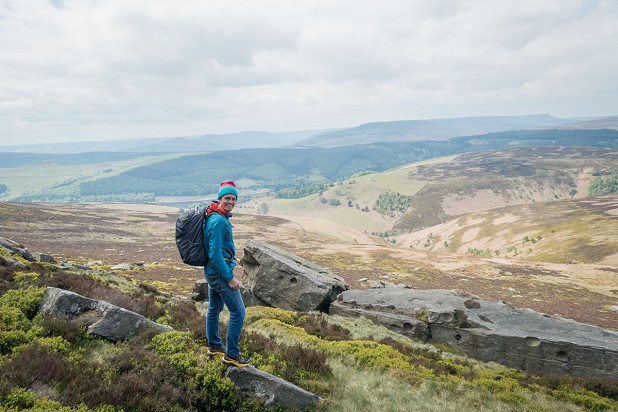
The frame consists of a lightweight spring steel and aluminium frame attached to a high-density polyethylene (HDPE) sheet. When combined these offer a sense of structure, rigidity and support. The HDPE layer also means that you can be a little lazier whilst packing, because it prevents any awkward edges from sticking through to your back. On that note, this isn't a back system with breathability in mind - it's a back system with stability in mind. It fits close, hugs close and as a result if you're working hard you're going to sweat.
Both the shoulder straps and the hip belt feature dual density foam and mesh outer. The latter doesn't necessarily stop you from sweating, but it does push the moisture away from your back. Comfort-wise I've carried the Outcast on everything from short approaches to local sport crags, to long walk-ins to more adventurous mountain crags/sea cliffs. Throughout both it's been comfortable and supportive, hence why I think it's suitable for more than just sport climbing, which leads us onto the next point…
Functionality
As per the opening paragraph, the Outcast is marketed as being a pack for sport climbers. Clearly this is where hinge fold packs are most commonly used, but I guess my question is why sport alone? Granted, sport crags tend to be closer to the road - hence don't need as robust a carrying system, and you don't need quite as much kit; however here we have a pack that is suitable for long walk-ins, and with more than enough capacity to cater for a trad rack.
On the note of trad rack, the fact it's hinged is arguably of greater benefit to organising and accessing gear than a traditional mountaineering pack with top access. Here you can simply fold it open and pick out your wires, cams and quickdraws quickly and simply. Now it's worth noting that I haven't used the Rogue, hence can't compare the two like-for-like, but what I can say is that you shouldn't write the Outcast off as a pack suitable only for sport climbing. For what it's worth, I've used it a lot for bouldering too, as it has the ability to fit in everything you need and more. In short, it's a pack for all occasions, barring those that involve snow and suffering.
Capacity
As mentioned already, the Outcast has a 44 litre capacity. This is large enough for pretty much most days out trad climbing and sport climbing, depending on how many sandwiches you like taking with you to the crag. The only caveats I would give to this are with regards to the rope, and where you choose to carry it. Clearly putting your rope into the pack takes up a vast chunk of the capacity, especially given the trend for longer and longer ropes. Put a single 80m rope in there and, even if it is super skinny, it's still going to take up a fair amount of space. With that in mind I've often opted to use a separate rope bag whilst sport climbing, simply because it frees up a bit of room, but also because I'm frequently walking such short distances that I'm not really bothered about the additional weight; however, it's worth mentioning this is an individual choice.
For those who don't want to pack their rope inside there's a clever space to securely store the ropes on top of your shoulder straps, which is quite a neat solution. Due to the presence of the clip/strap above it they're also secure, so if you are having to scramble over rough terrain then there's no risk of them falling out.
Whilst this could be considered a 'feature' I'll include this under capacity, as it ultimately relates to how much you can carry. There is room for a water bottle on one side and a clipstick down the other. When carrying a clipstick you're realistically looking at just the short and regular sizes, because if you've got a Long/XL one then it's probably worth carrying it by hand - especially if you're walking somewhere with trees for it to get caught in.
Another feature worth mentioning is the top pocket, which provides storage for valuables and other essentials. It's been designed with guidebooks in mind too, with enough volume to comfortably fit even the largest of Rockfax guides. On the inside of the pack there's a further zip-up valuables pocket stitched in, which provides the perfect place to put your keys.
Weight and Build Quality
The Outcast weighs in at just over 1.5kg, which - given all the above - shouldn't come as too much of a surprise. Given its focus it's not designed to be the lightest pack out there - it's designed to be a comfortable, burly climbing pack. With that in mind I won't dwell on the weight too much, because if it's light you're after then this is most definitely not the pack for you - buy a mountaineering pack instead.
One positive of the extra weight is that the materials used are durable enough to last a long, long time. The ballistic nylon outer takes a lot of abuse, so much so that mine has barely a scratch (despite a great many attempts). Ordinarily I'm a little paranoid about zips breaking, but the one featured on the Outcast feels robust enough to belay off (n.b. don't...) and has been reinforced with a protective flap at the base in order to prevent any damage from it being dragged around.
All-in-all the Outcast is a pack that's designed to be dragged around in the dirt and I can see it lasting long into the future.
Features
The stand-out feature is arguably its twin storage compartments. Whilst you can clearly put what you want where you want, it's good to keep the heaviest items lower down and close to your back. For me, given what I've already said about the rope, that means items such as my quickdraws and GRIGRI if I'm sport climbing, and wires, cams and quickdraws if I'm out tradding. Lighter items such as shoes, chalk bag and harness go in the front compartment, which is separated by a zip-up mesh lining (with a handy piece of velcro at the top - ideal if you're after quick in/out cover).
Lowe Alpine have provided a tarp and straps for you to put your rope against your back and loops within the front compartment where you can clip your quickdraws. I'll leave each individual to choose which system they use, as it's ultimately up to you.
The only aspect of the pack that annoys me is the grab handles. One is on the outside of the pack and is made of thick, reinforced webbing, while the other is on the inside and features a much slimmer/floppier construction. The combination is quite annoying, not least because the more obvious thing (in my eyes) would have been two grab handles on the outside. This makes sense on several levels, both in terms of grabbing the pack and moving it over short distances (which, granted, you can do with the current setup), but also closing the pack. With the design as is, you can't do that, because understandably one of the handles, namely the one on the inside of the pack, isn't something you can keep hold of whilst trying to zip the pack together. This is most noticeable when the pack is full to the brim.
Summary
The Outcast is branded as being 'the ultimate sport climbing backpack', but I'd go one step further and say that it could be the ultimate cragging pack, albeit with a few caveats. It's certainly not the lightest, but it packs a punch in terms of the support and durability it provides - hence is a solid purchase for the summery all-rounder wishing to invest in something that's going to last a fair few years. Features-wise it doesn't go overboard, keeping the design pleasantly simple and focussing on function. The fact the only downside I could come up with was that it didn't have two grab handles on the outside speaks volumes, because - let's face it - it's a bit of a minor gripe!
Lowe Alpine say:
The Outcast 44 is the ultimate sport climbing backpack. With a book-style opening, rope tarp and reinforced clip-stick holder, it provides a quick and easy way to stash gear and move from route to route.
Built from tough 840D ballistic and 420D nylon, with a sleek aesthetic and reinforcement in high-wear regions, our durable Outcast 44 climbing pack is designed for effortless mobility at the crag. Featuring the TriFlex carry system, an internal spring steel frame helps transfer the weight to the lumbar and hip belt, for a supportive carry.



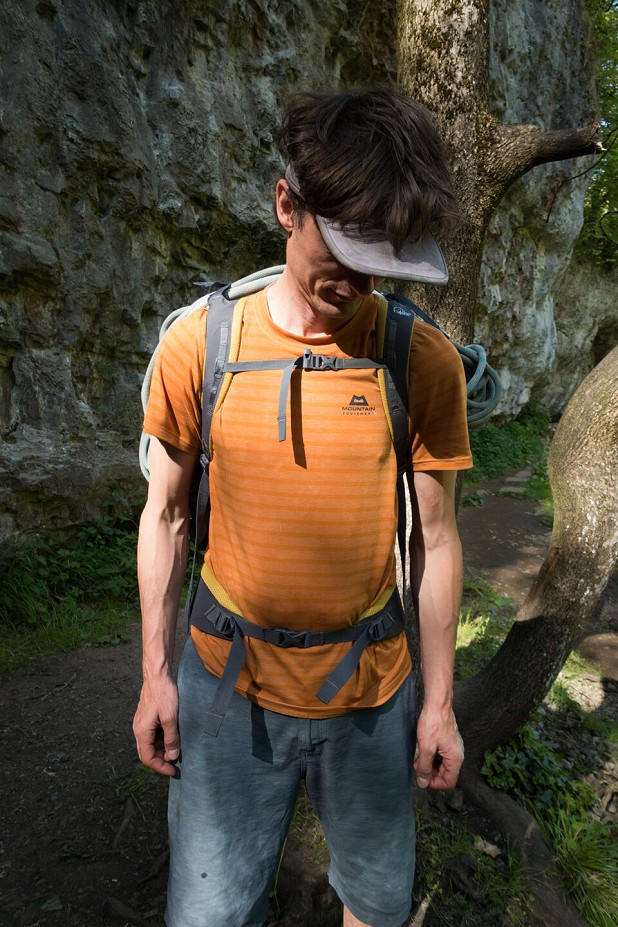
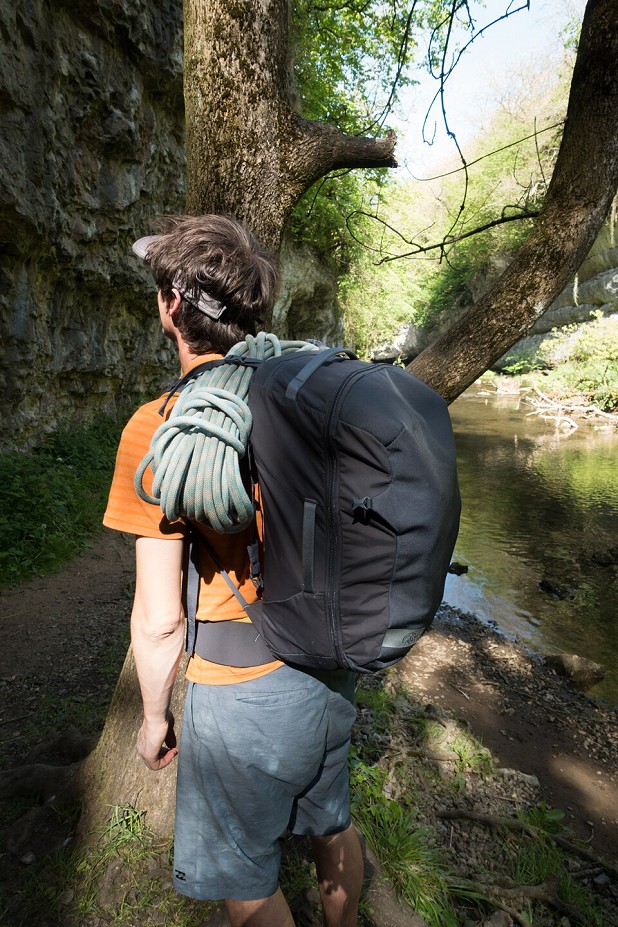


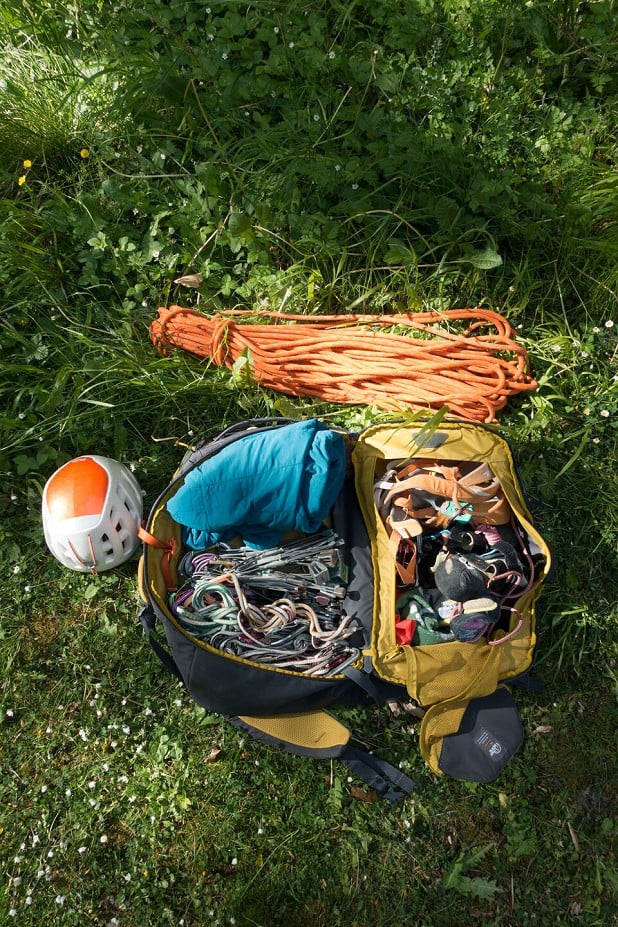
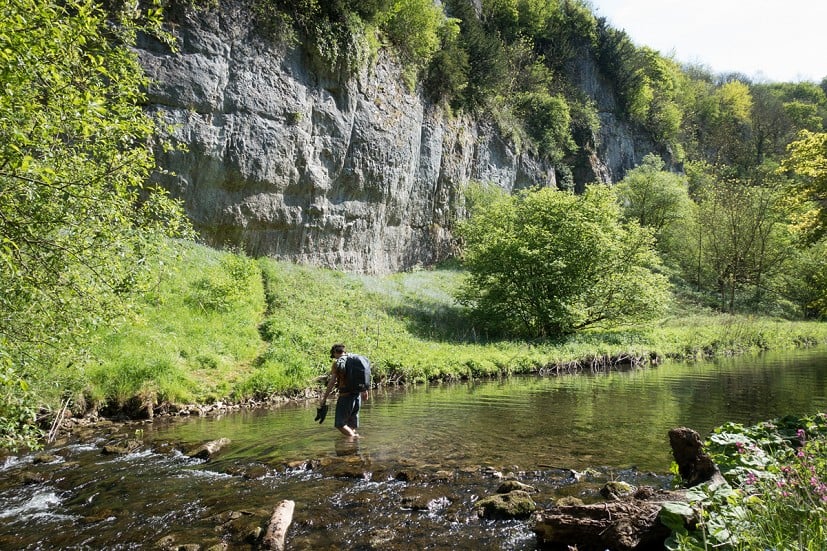
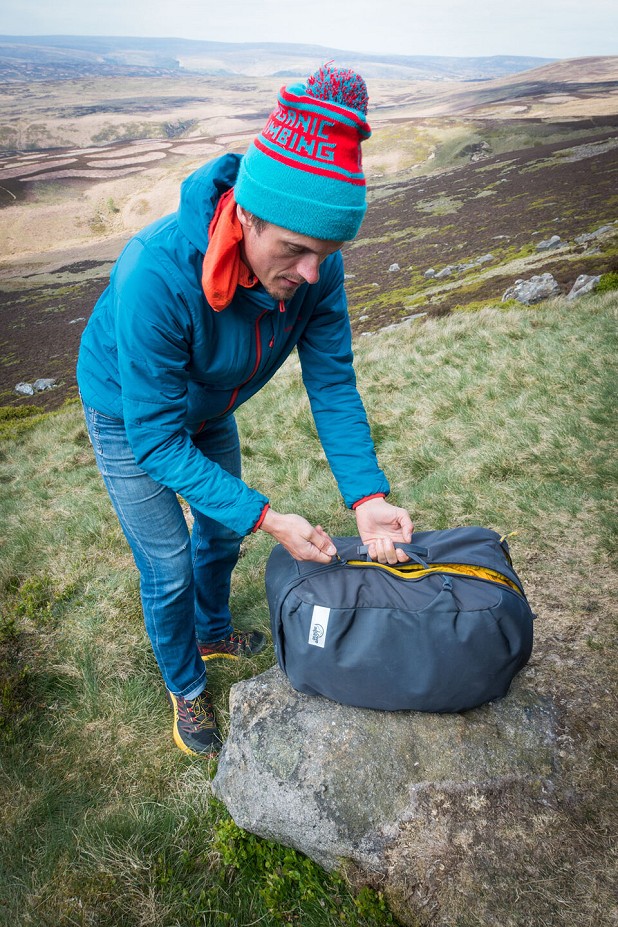
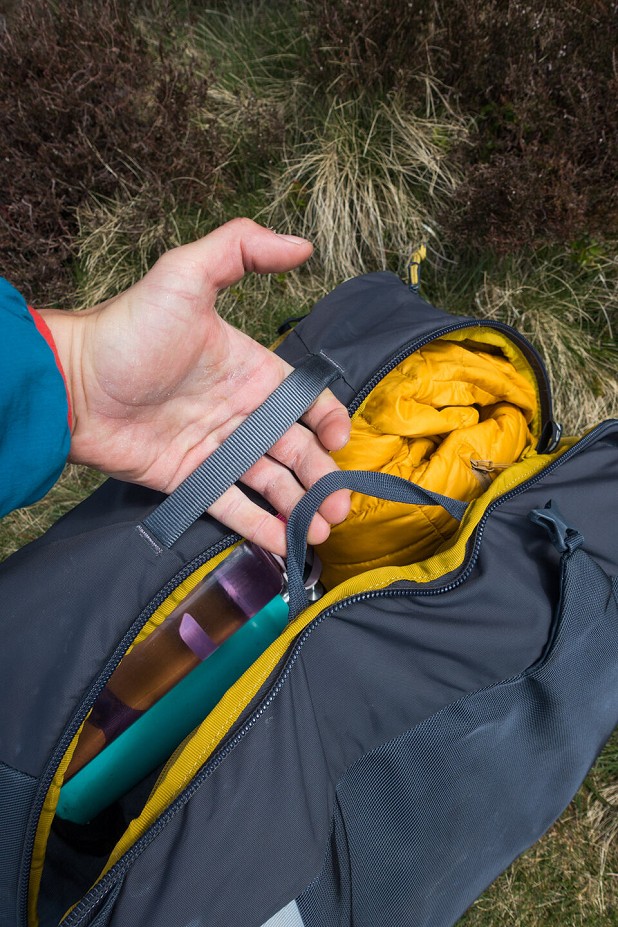
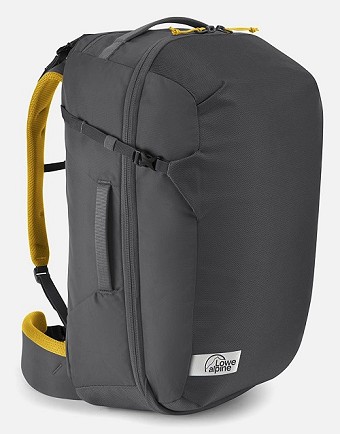

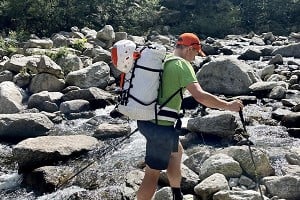





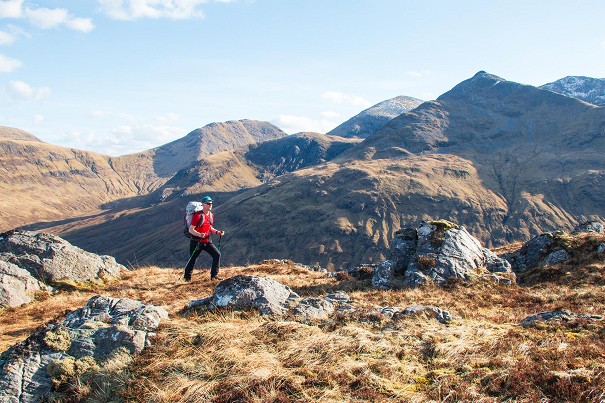



















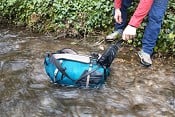




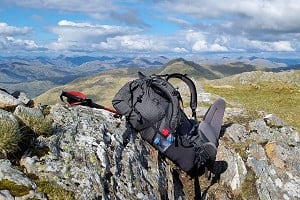
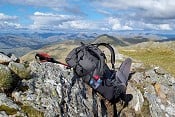
Comments
I genuinely thought the 'carrying the rope above the shoulder straps' was a marketing photo fail when I first saw it. Does it really work well? What if you like the pack close to your back (it being full of trad gear and you have uneven terrain)?
It certainly worked better than I thought it would, but if I could fit the rope in the pack then that was my preference. Generally speaking I - probably much like you - don't like having stuff stuck to the outside of my pack.
Somewhat counterintuitively it tended to be sport climbing where I carried the rope separately, because a chunky single rope tends to take up a lot of space - hence I'd either carry it as per the picture (with a tarp for the crag) or within a separate rope bag.
For trad, despite having much more kit you tend to share it between two people, plus the ropes are a lot more slender. As a result I pretty much always packed my ropes inside, not least because the approaches tended to me much longer and more involved than whenever I was out sport climbing.
Hope that answers your question.
Thanks. Looks like you could drape a rope over the top of the pack itself and fasten it to the top handle and side straps? But you're right, if I was sport climbing, I'd have a shoulder rope bag. I guess I'd be interested in this pack for short-haul trips, with this as main hand luggage -- size-wise it looks like it should be ok as long as it squishes a bit width-ways.
So it's a DMM Flight without the helmet carry and extra rope carry straps, but with a clipstick holder?
There's quite a lot of extra refinement to the design beyond that, which are quite apparent once you've got your hands on one.
In terms of what's missing, you're quite right - the helmet carry is one and the grab handles are another. It is also slightly larger, which could (in reference to Mark's question) present something of a problem when using it as carry-on luggage whilst flying (which is something I meant to cover within the review).
In terms of what's added the clipstick holder and extra rope carrying straps are fairly minor league compared to the big change, which is essentially the structure of the bag and its back system, which is leagues ahead of the Flight in terms of its sophistication. The Outcast is a much more proficient load carrier than the Flight as a result of this, making it more appropriate for trad, as well as sport, and generally having bigger days out.
Finally, it may or may not surprise you to hear that the same person designed both bags - hence more than a passing resemblance :-)